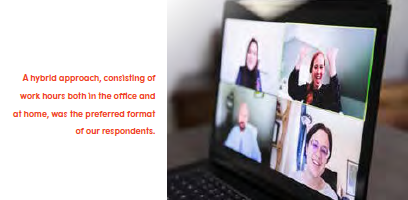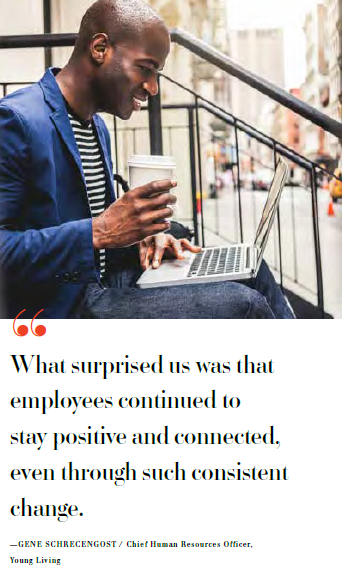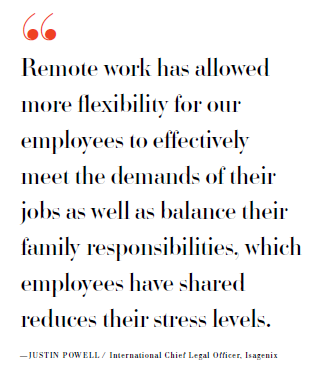COVID turned the traditional workplace on its head. How are direct selling companies managing the prospect of returning to the office—or will they?

Despite the diversity of attitudes about what constitutes the best working environment, one reality is hard to dispute. The global pandemic has forced a reckoning of sorts about what’s really necessary for employees to be productive, and the truth is that there is no single answer. However, granting employees flexibility in their workplace environments may lead to improved morale, longer tenure and a competitive advantage for those companies who potentially can cast their nets wider for talent. The industries with the highest number of remote workers are healthcare (15 percent), technology (10 percent) and financial services (9 percent), according to video conferencing company Owl Labs.
In March 2021, Prudential commissioned a survey entitled Pulse of the American Worker: Is This Working? A Year In, Workers Adapting to Tomorrow’s Workplace. This study of 2,000 adults working full time found that 87 percent of American workers who have been working remotely during the pandemic would prefer to continue working remotely at least one day a week, post-pandemic. Among all workers, 68 percent say a hybrid workplace model is ideal. That’s a double-digit percentage point jump from a similar question in a survey conducted in fall 2020. It suggests that the pandemic has highlighted what American workers value most in their respective places of employment.
Further, these responses indicate that such perks as flexible schedules and the reduction or elimination of daily commutes potentially outweigh any drawbacks associated with remote work, like isolation and increased work hours. Most consequential, the survey found that employees who don’t have access to the benefits they want post-pandemic are prepared to seek them elsewhere if necessary. Nearly half of current remote workers (42 percent) say if their current company doesn’t continue to offer remote-work options long term, they’ll look for a job at a company that does.
It’s not just employees who have had a few revelations during the pandemic. Their employers, too, are reconsidering what the optimal work environment looks like. We reached out to several direct selling companies to find out how they’re managing the future of their respective workplaces and what they’ve learned in the process. Here’s what we learned:
Hybrid Format Preferred
A hybrid approach, consisting of work hours both in the office and at home, was the preferred format of our respondents. That decision was usually based upon employee feedback, which drew companies’ attention to the fact that the pandemic was having disproportionate effects on caregivers of preschool and school-age children and elderly family members, as well as those with preexisting health conditions. At the same time, direct selling executives recognized that there were inherent challenges associated with a purely remote work environment – namely, maintaining strong and personal culture, bringing new employees into the fold and continuing to recognize, motivate and engage existing employees.

While leading a Zoom call several months ago, It Works! Founder and CEO Mark Pentecost looked at the faces staring back at him from his computer screen and had a revelation. He recalled the incident during a Direct Selling News Executive Insights interview with Stuart MacMillan, President of MONAT Global: “I was looking at the different people in the Zoom, and I’m like, ‘Oh my goodness, I haven’t said good job to her, or I haven’t congratulated that person.’ It really overwhelmed me. How do I show appreciation? My background’s coaching. I coach someone who’s maybe underperforming, or tell someone who’s really knocking it out of the park that ‘I see you. Nice job, I really appreciate it.”
It Works! reopened its corporate office June 1 as part of a hybrid work solution for employees. “Our secret sauce is the hugging and acknowledgment and pats on the back. It’s not as easy to do that out of your home,” Pentecost says. “There are three things I’m focused on—boosting engagement, encouraging collaboration, and increasing morale. I wanted to make sure our field team knew how much I appreciated how they’re working through this period. And those are the three things that I realized people needed the most.”
Following a lot of discussions, Team National recently announced its 2021 hybrid plan for employees. “We’re allowing most staff—a few job descriptions aren’t favorable to work from home, so those staff are in house, such as our network administrator—but most may choose to work from home daily, come in daily, or split their time in any given week,” says Angela Loehr Chrysler, President and CEO. “All new hires must be in office for their probationary 90 days for training and then, if eligible, they can request work from home. But to keep our fun, family-friendly, ‘treat others the way you want to be treated’ culture, we require all staff to be in the office every other month for two to four days by department.” Department heads will coordinate their team members to be together those two to four days to encourage in-person collaboration and discussion. Staff members also will be required to be in the building for special events. Team National’s first all-staff day took place July 16 when one of the company’s top leaders was in the office for a special event.
“We’re mostly remote at the moment, but we’re working on a phased approach to welcoming employees back to the office at our Gilbert, Arizona, headquarters—voluntarily, with encouragement and incentives—given our culture thrives on in-person interaction and collaboration,” says Justin Powell, Isagenix International Chief Legal Officer. “From a more long-term perspective, we’re revisiting our remote work policy, which represents a hybrid approach, and expect to expand it to allow maximum flexibility for eligible employees to work remotely on a more regular basis as long as business needs are being met.”
Mental Health Comes into Sharper Focus
About one-third (31 percent) of all respondents participating in the Deloitte Global 2021 Millennial and Gen Z Survey reported that they have had to take time off of work since COVID due to stress and anxiety. It’s incumbent on employers, then, to support employees’ mental health through any means possible—and reconnect with their purported and respective missions.

Referencing the Deloitte survey, Brent Willis, CEO of NewAge, says, “The incremental stress of COVID coupled with an accountable and performance-oriented work culture is a change. So, we focus on over-communication, building the right culture, and engaging with all associates so they feel heard, valued and connected to the purpose and cause of the company.”
For NewAge, COVID has left an imprint on the company’s culture, inviting an even more egalitarian, collaborative style as employees leave individual offices behind for a new space that allows them to more easily engage with coworkers—whether they’re three desks down or working remotely. “NewAge is completely redoing the office model of old,” says Willis. “We’re going to hybrid systems, hoteling, building social studios in every location around the world for brand partners, and creating community hang-out spaces, so our offices have become ‘multifunctional hubs’ instead of desks with stacks of paper and pictures of grandma. We’re creating multifunctional collaboration, coordination and training spaces, and eliminating many of the expensive mega shrines of the past. Even the CEO has no door—just a few comfy chairs for meetings and a stand-up desk.
“We love the value of social connection, instant coordination and informal communication that has historically come from an in-office work environment,” he continues. “But we have learned that with all of the digital connectivity tools available today, you can achieve all those things without physically being in the same space all the time.”
The Takeaways
Preparation is key.
If the pandemic taught us all anything, it’s the critical importance of preparation. Those companies who had the technical infrastructure in place before the pandemic were more agile and could pivot to remote working environments more easily.
In the process, companies reaped the benefit of several key learnings they plan to incorporate into their ongoing operations. “Working remotely helped us better utilize technology to improve collaboration with our international offices, so we’ve been increasing our efforts to work more seamlessly together,” Powell says.
For Young Living, the pandemic has served as a reminder of the value of sound crisis management procedures. The company established a crisis communications process and application where employees could receive real-time updates and remain informed as local and national agencies set health and safety guidelines. “It’s very important to have a plan and to be able to communicate to your entire workforce as quickly as possible when a major crisis occurs,” says Gene Schrecengost, Chief Human Resources Officer for Young Living. “What surprised us was that employees continued to stay positive and connected, even through such consistent change.”
Involve employees in decision-making.
As Mary Kay Ash so wisely said, “People will support that which they create.” Taking the pulse of employee sentiment about optimal work environments has served direct selling companies like Isagenix well. The company deployed an anonymous survey to its U.S. workforce to gather feedback, “which we felt was a critical component to our return-to-office planning,” says Powell. “The survey was designed to measure current and future attitudes around coming back on-site at our headquarters. We’re taking that into account as part of our return-to-office plans.”
As for It Works! hybrid work style, “I want it to be led by our employees,” Pentecost said in his Executive Insights interview with MacMillan in July. “I want them to tell me what they need to be the most efficient. The world’s never going to be the same. We’re going to go back, and it will be different. There are no rules we need to follow. How much do we need to be in the office? What departments never need to be in the office? Who needs the collaboration and people? We’ve started opening the office so that if you want to come into the office, you’ll be able to. We’ll be there. We’ll sanitize. We’ll keep it safe. We’ll have some rules, but we’re not going to tell you yet that you have to come back, or you have to do this.”
Have clear guidelines in place.
Plexus’ new policy includes clear eligibility guidelines and best practices for effectiveness and team collaboration. “When the pandemic hit, many office-based organizations had to move quickly to transition teams to work from home,” says Mary Beth Reisinger, the company’s Chief Human Resources Officer. “This is not the same as deliberately offering a telecommuting option. One was out of necessity; the other was intentional. Setting rigor around what telecommuting looks like, giving leaders the flexibility to determine what schedule works for their teams, being intentional about culture-building, and lots of communication are a few vital elements. Additionally, we held mandatory training for leaders to focus on team building, accountability, and measuring performance.”
“Challenges with a flexible working situation are likely the same at any company,” says Schrecengost. “We worked with our Legal team to establish a ‘Ways of Working Policy’ in which we outlined the expectations for all employees eligible for flexible working arrangements. This policy allows everyone to be on the same page about meeting performance standards and keeping in communication with each other as we move into a blended working environment.”
Keep employees around the campfire through any means available.

Direct selling companies, like the independent distributors they serve, in large part have been founded on strong cultures. Gathering one’s employees around the campfire, so to speak, will almost certainly be a challenging prospect when they’re rotating in and out of the office. Companies like Plexus are striving to create a happy medium between offering greater flexibility and maintaining the kind of culture they need to gain employee buy-in, fulfill their objectives and keep retention high.
Fridays are sacred days at Plexus, reserved for events like team celebrations, cultural initiatives, weekly raffles, so “our hybrid work environment offers eligible team members the choice of working from home two days per week, with the exception of Fridays,” says Reisinger. “We recognize that we will have to be more deliberate at maintaining a team-like atmosphere, so we’ve trained and tasked our leaders with cultivating an inclusive and dynamic team environment.
“Although 2020 was a strong year for our business, we learned that the stressors of the pandemic and an overnight shift to work from home were not optimal for our team members,” she continues. “Innovation and cross-functional collaboration slowed, and our new hires didn’t get the benefit of cultural immersion. A key takeaway was that we would need some additional structure and imagination to ensure that moving to a hybrid work environment going forward would still support and preserve those things.”
Young Living “struggled to stay connected as a greater team,” Schrecengost says, “so our Employee Experience teams held weekly ‘happy hours’ where our employees could connect and laugh with our executives and leaders over video conference. This helped employees feel more connected even though we were working apart.”
Reassess periodically.
Companies generally are approaching the transition to hybrid work on a contingent basis; they’re rolling it out, seeing how it goes and intend to revisit it after a trial period. Team National, for example, will review its work from home policy at the start of 2022, Loehr Chrysler says, to determine if adjustments need to be made or if it should remain as is. At this time, the company has 20 employees who split their time in and out of the office and another 23 who work from home daily.
The Future: Remote Work as an Employee Benefit?
As our economy continues to recover and employees feel emboldened to start making changes in their respective careers, direct selling companies will inevitably begin to consider how they can distinguish themselves in a competitive market. Could offering such benefits as remote work tip the scales in your company’s favor? The following statistics, compiled by Findstack.com, are worth considering:

- 99 percent of people would choose to work remotely for the rest of their lives, even if it was just part-time (source: Buffer).
- Remote workers save around $7,000 per year in transportation, food and childcare (TECLA).
- Companies that allow remote work see an average increase of $2,000 in profit per remote worker (Stanford).
- 64 percent of recruiters say that being able to pitch a work-from-home policy helps them find high-quality talent (IWG).
- In 2017, there was a 50 percent decrease in resignations in companies that allowed remote work (Stanford).
“Remote work has allowed more flexibility for our employees to effectively meet the demands of their jobs as well as balance their family responsibilities, which employees have shared reduces their stress levels,” says Powell. “In a survey of our U.S. employees, they reported that remote work has had a positive impact on their personal productivity, work satisfaction, and collaboration.”
This isn’t to imply that remote work is without its complications. Social media management software company Buffer found that the three biggest challenges associated with remote work are unplugging after work (22 percent), loneliness (19 percent) and communication (17 percent). Seventy percent of remote workers report receiving regular training from their companies (TalentLMS). Fifty-four percent of IT professionals consider remote workers to pose a greater security risk than traditional workers (OpenVPN).
No Single Solution
Ultimately, what determines the ultimate success or failure of any new workplace policy differs from company to company.
“I think this is a case where one-size-fits-all solutions unfortunately do not exist; different conditions may call for different approaches,” said Raffaella Sadun, professor of business administration at Harvard Business School, in an article for Harvard Business Review {“COVID Killed the Traditional Workplace. What Should Companies Do Now?” by Dina Gerdeman; March 8, 2021). “A practical piece of advice is thus to be proactive and elicit workers’ preferences and explore different approaches now. The return to the office may not be as simple as we imagined at the beginning of the pandemic.”
In January 2021, Oakland, California-based management consulting firm Great Place to Work released the results of its survey of 79 executives from 56 Fortune 500 companies.
The surveyors wanted to gauge leaders’ thoughts and plans for returning to the workplace, or if a return was in their plans at all. Pre-COVID, the average percentage of employees working from home for these companies was just 16 percent. Perhaps not surprisingly, executives were divided on the subject of how working from home has affected company culture and productivity:
- 50 percent of executives surveyed believed productivity wasn’t impacted by remote work.
- 30 percent of executives believed teams were more productive while working from home.
- 20 percent reported mixed impacts across teams and business units, with some improving while others appeared to be suffering.
Additionally:
- Most leaders were targeting a return to the workplace within the next 7-12 months.
- Camaraderie and morale (61 percent) and collaboration (45 percent) were the top ways executives expected returning to the office would improve company culture.
- Over half (58 percent) anticipate reducing their office space by at least 10 percent from pre-COVID needs, and over one-third expected to reduce their office space by 25 spaces.
- Three out of five executives believe up to 25 percent of their workforce will continue to work remotely full time.
From the September 2021 issue of Direct Selling News magazine.


